Roof Structures
Problems with wet rot and woodworm
Building Surveyor's Expert Advice
1stAssociated.co.uk have Building Surveyors who can provide building surveys, structural surveys, independent valuations, property surveys, structural reports, engineers reports, specific defects report or any other property matters.
Our Surveyors use survey sketches and photos in our reports to emphasise our findings, as the feedback we have from our clients is that the sketches and photos help them understand the reports.
We, of course, like to meet you at the property during the survey and we are more than happy to talk to you about the reports. Please free phone 0800 298 5424 for a friendly chat with one of our surveyors.
The roof structure or framework must be built in a manner which is able to give adequate strength to carry its own weight together with that of the roof covering and any superimposed loads such as snow, wind, foot traffic etc. During our surveys we come across many different types of roof structures.
Pitched Roofs – where do we start?
Crucks Frame House
The original Crucks frame house was little more than a roof as two timbers were leant against each other. From the photo you can see how the house was practically an upturned V. Back in the days when we used local materials known as vernacular architecture we would have cleared the area and peg fixed the roof structure and walls together. We are sure we once read that the timbers were actually weighted to make them bend in such a manner but we can't recall where we saw this statement made, it simply may be urban rumour, but it is something that we have come across during our time as a surveyor.
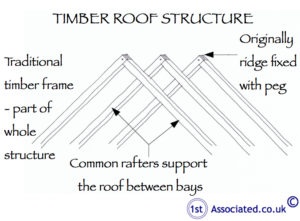
Crucks Frame roof structure
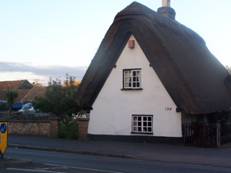
Timber roof structure
We don't come across many Crucks timber frame buildings however we do come across quite a lot of timber frame buildings that have peg fixings.
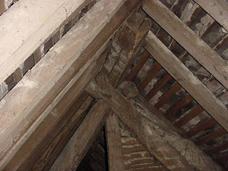
Pegged roof structure
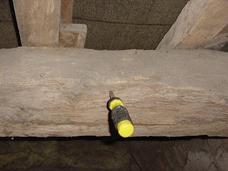
Checking to see if the timber is soft
Georgian Roof Structures
Georgian Roof Structures often have butterfly roofs. We believe this is because they didn't know how to span larger distances. The central valley gutter can cause all sorts of problems.
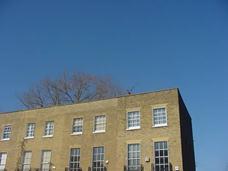
Hidden Front Georgian roof behind
parapet walls
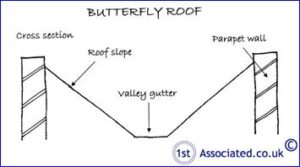
Butterfly roof
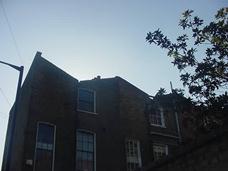
Rear of Georgian Roof showing a
Butterfly roof structure configuration
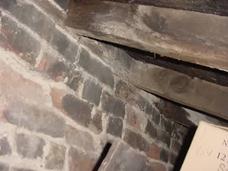
Dampness in Butterfly roof
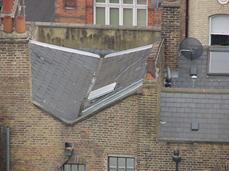
Butterfly roof
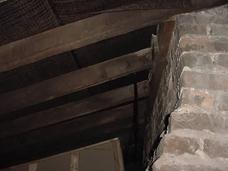
Butterfly roof structure take
support from wall plate
This is the area where problems occur and dampness gets into the structure.

Valley gutter to a butterfly roof structure
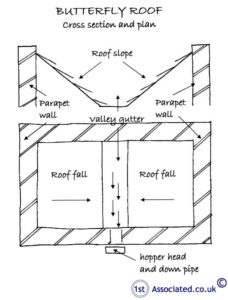
Butterfly roof cross section
Mansard Roof
Mansard roofs typically have problems with regards to the drainage to the front and rear but this does depend upon the detail. Please see the sketches of a typical mansard roof and typical problems that can occur to the parapet wall.
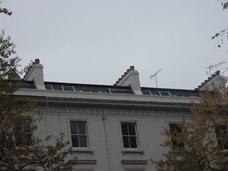
Mansard roof just visible

Mansard roof
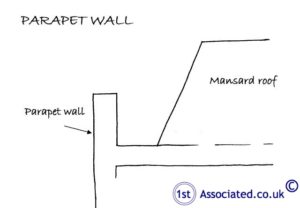
Parapet wall to mansard roof
The reason we put them in this section is that Mansard roofs are often added to Georgian properties where utilising the roof space and effectively giving a free extra storey to your building.
Victorian Roofs
It is true to say that all roofs up to this era had been hand cut and many, many Victorian roofs look like the hand cut sketch or the A frame sketch. On larger roofs the Victorians did use different methods which we won't go into here.
One of the main problems we come across with roof structures on Victorian properties is where the original slate has been replaced with heavier concrete tiles. This weight is difficult for the common rafters and the purlin to support. This can cause distortion in the roof structure. We have come across cases where the walls have been pushed outwards because of this.
Purlin defined
Horizontal timbers which help give support to the common rafters which form the pitch of the roof.
Common rafters
Timbers which form the pitch of the roof.
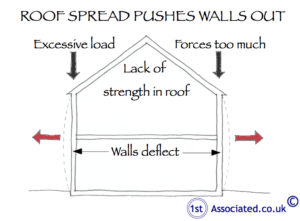
Roof spread pushes walls out
Hand Cut Roof
A cut timber roof is purpose made and hand built on site. Over the years there have been many different types of hand cut roofs starting from the old original traditional timber frame roofs which were cut and put together without any nails or metal fixings which were there to be viewed and really were a work of art. You are more likely to have in your property, if it is pre-war, a cut timber roof that has been purpose made for the property which could look like either of our two sketches.
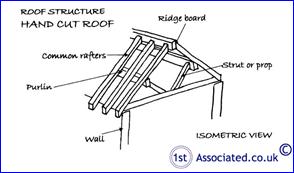
Hand cut roof
A Frame Cut Timber Roof
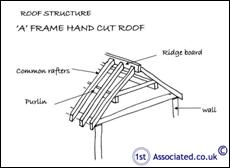
War Years and Post War Years
Whilst these also did occur in earlier eras a hipped roof is very much in our mind something that is post war.
Hipped Roofs
The problem with the design of the hipped roof is that the roof sits on itself rather than onto a wall. Due to the construction of hipped roofs, they are prone to slipping or to dropping which can, in extreme cases, push the walls out.

Hipped roof
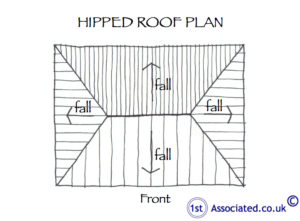
Hipped roof
Problems with hipped roofs
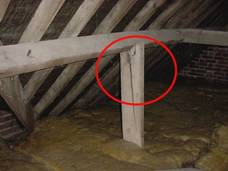
Split in an additional support given
to a hipped roof.

Further additional supports on a
hipped roof splitting
Close Boarding
Older style hipped roofs are sometimes close boarded which generally makes them a very strong roof however we do come across many cases where there is no close boarding. Close boarding however is a rarity and most hipped roofs don't have the luxury of close boarding.
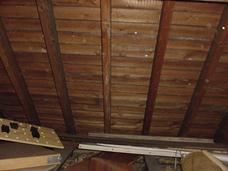
Close boarded roof

Close boarded roof
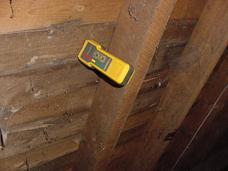
Damp in close boarding of roof
structure
Coupled Roof
Older roofs have what is known as coupled roofs, this is where the ridge is fixed with a peg.

Timber roof structure

Dating the age of the property the way the roof structure is finished
Whilst many roofs have been re-roofed over the years, (by this we mean not just the roof covering of slates or peg tiles or thatch, but the actual roof timbers themselves) in a modern property we will see a modern breathable protective underlayer (see photos below). The older roofs also have a breathable protective underlayer, this is known as blinding, this is where lime mortar is used to bed/seal the roof covering.
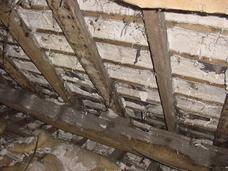
Blinding
Protective Underlayers
From the 1940s onwards felts were used underneath tiles/slates to stop wind damage and water penetration, these in more recent years have been replaced with plastic equivalents. These are commonly known as underfelts but now the name is not really appropriate, as felt is not the only material used.
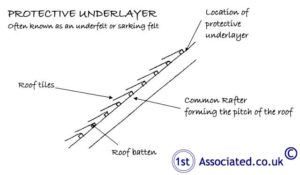
Protective underlayer
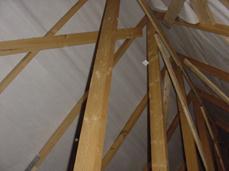
Protective underlayer
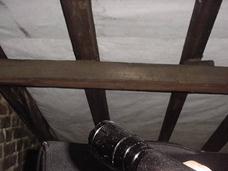
Protective underlayer
Non-traditional construction roofs
This is where a structural frame was erected and the walls were then hung off it. The structural frames can be metal, concrete or wood. Prior to purchasing a non-traditional construction property it is critical that it has a building survey to ensure there is no major deterioration to the structural frame. Many mortgage companies will not lend on this type of property unless a structural survey is carried out.
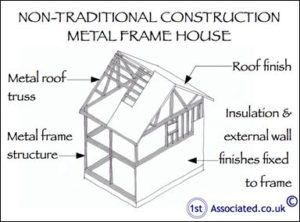
Non-traditional construction
metal frame house
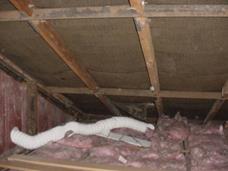
Metal frame roof structure.
Essential that vents are
extracted to outside air to
ensure rusting does not occur.
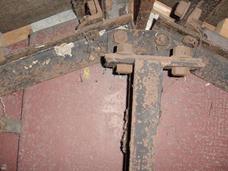
Rusting to a lightweight metal
frame or damage or deterioration
to the metal frame of a
non-traditional house
Modern roof structures
Modern roofs are often known as engineered roofs. This is because the timber within them is minimal.
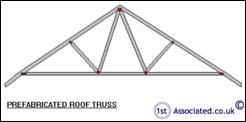
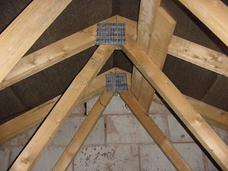
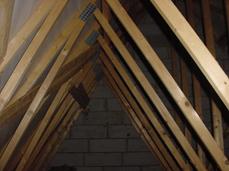
Peg fixing on relatively
modern timber
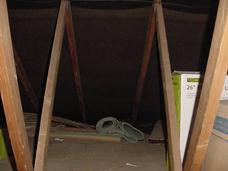
Peg fixing
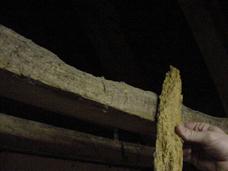
Peg fixing
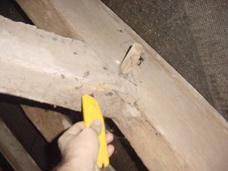
Peg fixing
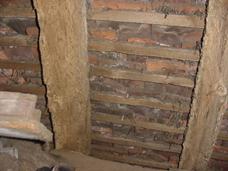
Back of peg tile, although most
of the pegs are missing and many
have been replaced by nails that
have now rusted, known as
nail sickness
You may also find the following articles of interest:
Changing quick weather causing Spring house problems!
Leaking Dormer Roof
Modern timber frame properties and their common problems
Not so common pitches roofs
Problems with roof timbers
Blackened roof timbers
The photographs show blackened timbers which occurred when the property had no first floor and fires/smoke went up into the roof.
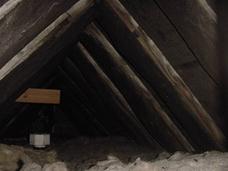
Old roof with blackened roof
timbers from when there was an
open fire
Damp in roof structures
This can affect any age of roof structure and often comes about due to lack of maintenance, poor detailing or more frequently today we are coming across problems which are caused by lack of knowledge and people not wanting to spend money on this area.
Wind and watertight
It is essential that roof timbers are kept as dry as possible and adequately ventilated to reduce the chances of dampness which creates an ideal environment for woodworm. Therefore any defective roof coverings should be repaired as soon as possible.
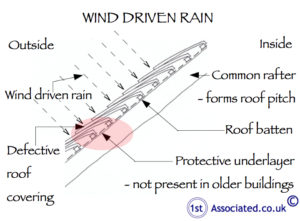
Wind driven rain
Woodworm
Woodworm can be difficult to identify as a lot is hidden by such things as insulation and the configuration of the roof. Frass is the chewed up sawdust that the beetle leaves behind. A light coloured dust and a light coloured hole indicates this is relatively recent. If it is a darker coloured frass, or darker coloured hole, it means it is older and the woodworm may have gone. If left untreated woodworm can cause structural problems . Often timbers will need to be replaced/strengthened in the property.

There is a section of the timber with
woodworm that we could pull away,
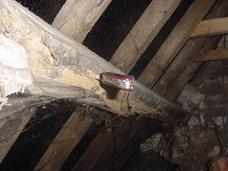
Timbers with serious woodworm
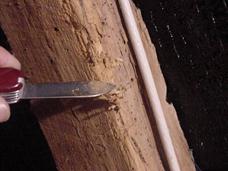
Woodworm in timber and
frass on top of knife
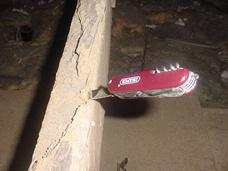
Woodworm in roof
Woodworm treatment
We are not great lovers of chemicals and would much prefer to use woodworm traps in the form of Anode Traps, which is sticky backed paper that catches the live woodworm but in some cases chemical treatment may be the only way to get some form of guarantee to enable the future sale of a property. We have often found that woodworm treatment can cause more damage than good and also often it is required to evacuate the premises.
Ventilation
Drying out the roof by stopping the dampness getting in will mean the environment is not as good for the woodworm; you can do this via adding ventilation. Properties should have adequate ventilation and should not be insulated disproportionately to the ventilation as this can cause condensation and provide a damp environment for woodworm.
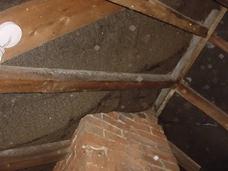
Mould in the roof
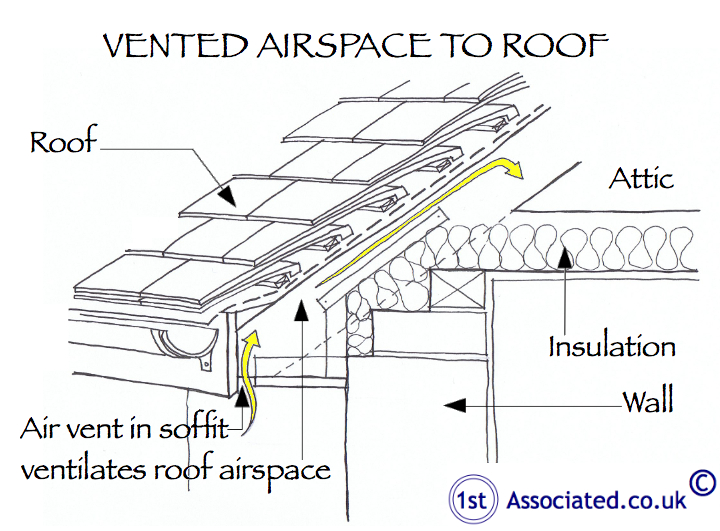
Vented airspace to roof
The weight of roof tiles can affect the roof structure
The roof structure needs to give adequate strength to carry its own weight together with that of the roof covering. Some roof coverings are heavier than others, i.e. concrete is heavier than slate. Of the tiles shown below the main culprits for adding too much weight to a roof are the concrete tiles. Other roof coverings are much lighter, particularly the natural slate and the man made slate.
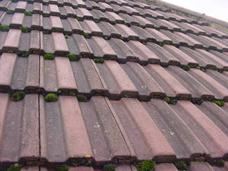
Heavy concrete tiles

Roman tile
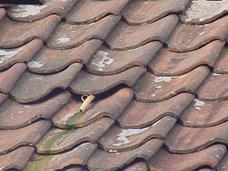
Pantiles
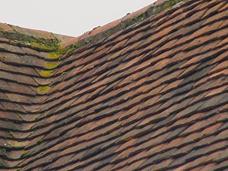
Clay tiles
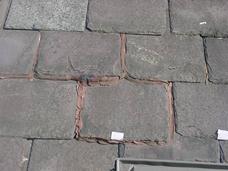
Slate roof
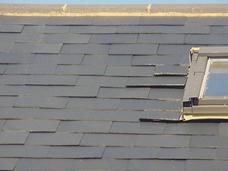
Manmade slates that were
lifting on an undulating roof
Additional Support in Roofs
I Beam support
When things go wrong with roof structures we have come across additions such as I beams that have been added or purlins which help give support to the common rafters forming the pitch of the roof. They also take some weight off the outer walls which is particularly important if they are moving.
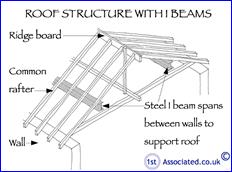
Roof structure with I beams
Independent Building Surveyors
If you want an independent expert opinion from an independent building surveyor then please phone us on 0800 298 5424 to have a free of charge friendly chat with one of our surveyors. We are happy to do valuations, building surveys, structural surveys, structural reports, engineers reports, specific defects reports, home buyers reports or unique building surveys.
We feel our surveys are quite unique, as they are written to your level of knowledge. The surveys include photos and sketches and definitions. The survey will also include an action required section and an estimate of costs in the executive summary. We are more than happy to meet you at the property whilst carrying out the survey to discuss any specific issues you may have or have a general chat about what we have found at the end of the survey.
We hope you have found this article useful
We hope you found the article of use and if you have any experiences that you feel should be added to this article that would benefit others, or you feel that some of the information that we have put is wrong then please do not hesitate to contact us (we are only human). For more information contact us on free phone 0800 298 5424.
The contents of the website are for general information only and is not intended to be relied upon for specific or general decisions. Appropriate independent professional advice should be paid for before making such a decision.
All rights are reserved the contents of the website are not to be reproduced or transmitted in any form in whole or part without the express written permission ofwww.1stAssociated.co.uk.

